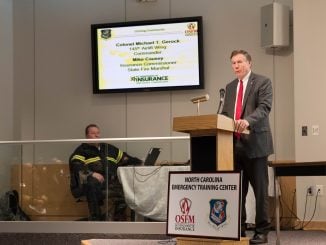
BOISE, Idaho — Months after a catastrophic fire burned more than 2,200 homes in Hawaii, some property owners are getting more bad news — their property insurance won’t be renewed because their insurance company has deemed the risk too high.
It’s a problem that has played out in states across the United States. Insurance providers, state regulators and researchers are grappling with how to keep the insurance companies in business while keeping residents and their properties insured and protected.
“I think most of the insurers, you know, I’m very grateful that they’re committed to the Hawaii market, so we haven’t seen wholesale withdrawals,” after the Aug. 8, 2023, fire burned through Lahaina and killed 101 people, Hawaii Insurance Commissioner Gordon Ito said during a Wildfire Risk Forum for insurance commissioners held at the National Interagency Fire Center in Boise, Idaho.
But one or two insurance companies have stopped renewing policies for wood structures like townhomes that are in wildfire risk areas, Ito said Monday, in part because the companies have seen their own insurance costs climb. Property insurers typically have their own insurance coverage to help when there are big payouts, like the roughly $3 billion in claims that have been paid so far on an estimated $6 billion in damages from the Lahaina fire. But those “reinsurance” rates are climbing, Ito said, and that’s forcing some companies to reevaluate the policies they are willing to issue to residents.
The same thing happened in Colorado after the 2021 Marshall Fire destroyed 1,100 homes in Boulder County, causing an estimated $2 billion in damage, said Colorado Division of Insurance deputy commissioner Jason Lapham. Last year, Colorado lawmakers authorized the creation of the Fair Access to Insurance Requirements (FAIR) Plan, which is expected to provide bare-bones property insurance coverage for residents who can’t get insurance from a private company starting in 2025. Other states like California, Louisiana and Florida have also resorted to providing their own state-affiliated “insurers of last resort,” which can fill in the gap when the private insurance market abandons an area because of natural disaster risk.
The economic effects of a catastrophic fire last for years, said Ito. Insurance companies in Hawaii have already paid roughly 80% of the claims filed for personal property, nearly 100% of the claims filed for motor vehicles and about half of the commercial insurance claims, he said. Commercial insurance claims typically take longer because additional records are needed to document the losses sustained by a business.
In North Carolina, property insurance companies have canceled policies or stopped writing policies in certain areas. In late 2023, Nationwide did not renew policies for more than 10,000 homeowners in North Carolina. Earlier this year, North Carolina’s top insurance regulator denied an industry request to raise homeowners’ insurance premiums by an average of 42% — and to almost double them in parts of coastal counties.
Insurance Commissioner Mike Causey set a hearing for October to evaluate the request and determine what is reasonable.
“People said that they were struggling with the higher cost of groceries and fuel, taxes have gone up in their localities,” Causey told reporters after the meeting. “So I heard loud and clear what the public said.”
An executive with the North Carolina Rate Bureau, a state-created entity representing insurance companies, said the industry has to account for inflation — which affects building material costs — and the increased frequency and severity of major storms.
“The very real cost of insuring homes in North Carolina has impacted what we all pay for insurance,” Chief Operating Officer Jarred Chappell wrote in an email. “Our bureau is responsible for collecting data on claims, and that data shows rates need to increase in order to maintain a healthy market in the state.”
The average increases sought by the bureau range from just over 4% in parts of the mountains to 99% in the beach areas within Brunswick, Carteret, New Hanover, Onslow and Pender counties. Proposed increases in the state’s largest cities in the Piedmont were roughly 40%.
Causey said he also empathizes with the homeowners’ insurance industry. He said one insurance agent told him that $112 in claims were being issued for every $100 in premiums taken in. But he said the industry must do more to tighten its belt and address insurance fraud.
Causey said he’ll preside over an evidentiary hearing starting Oct. 7, and if he finds the proposed rates excessive, he can then issue an order that sets new rates. That order could be appealed. And Chappell noted Tuesday that many rate negotiations over the years have been settled before the hearing. During the last round on homeowners’ policies, the bureau sought an overall average increase of 24.5% before a November 2021 settlement resulted in a 7.9% average increase.
“I’m willing to listen if they want to come back with some numbers that are more reasonable to the people because the majority of people can’t stand this,” Causey said.
Associated Press writer Gary Robertson contributed to this report.

